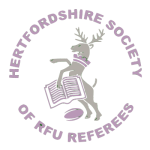
In this training, referees will…
- Understand the primary duties of an Assistant Referee
- Know when the ball is in touch
- Be able to signal effectively
- Be able to communicate effectively as a Team of Three
- Be aware of effective positioning
Primary duties of an A.R.
There may be occasions, like finals in competitions, where you are asked to be an Assistant Referee. This is an important and specific role where concentration and communication are key components.
The referee and you, are a team and must work together.
- The first priority is to indicate touch.
- The second priority is the identification and communication to the referee of all incidents of Foul Play.
- After these come other duties to assist the referee in managing the match – these may include communicating offside, knocks on, forward passes etc., where these are clear and obvious, and where the referee is not in a good position to make judgement.
The referee is the leader of the team with the onus on them to fully brief you prior to the match regarding obligations.
In touch?
The ball is in touch or touch-in-goal when;
- The ball or ball-carrier touches the touchline, touch-in-goal line or anything beyond.
- A player, who is already touching the touchline, touch-in-goal line or anything beyond, catches or holds the ball.
- If the ball has reached the plane of touch when it is caught, the catcher is not deemed to have taken the ball into touch. If the ball has not reached the plane of touch when it is caught or picked up, the catcher is deemed to have taken the ball into touch, regardless of whether the ball was in motion or stationary.
The ball is not in touch or touch-in-goal if:
- The ball reaches the plane of touch but is caught, knocked or kicked by a player who is in the playing area.
- A player jumps, from within or outside the playing area, and catches the ball, and then lands in the playing area, regardless of whether the ball reached the plane of touch.
- A player jumps from the playing area and knocks (or catches and releases) the ball back into the playing area, before landing in touch or touch-in-goal, regardless of whether the ball reached the plane of touch.
- A player, who is in touch, kicks or knocks the ball, but does not hold it, provided it has not reached the plane of touch.
A.R. signals
All signals should be given without flamboyance, by flag or via the communications equipment if used.
They can be categorised as:
- Decision signals, always given by a flag signal, at or above the shoulder (i.e. Touch, Goal, Foul Play offences

- Indicative/Confirmatory signals (e.g. Offside lines, Knocks-On, Forward Passes, Illegalities where the referee has indicated at the pre-matchbriefing that assistance would be appreciated). These should be given via the communications equipment.
Communication

Communication needs to be clear and concise.
You MUST give team colour and number of any clear and obvious infringement (i.e. Black 3 collapsing maul or White 6 side entry).
To communicate a scrum infringement, you should give colour of the offending team (gold, gold, gold), then follow this with the reason (eg “Tighthead binding on arm” or “Loosehead hinging.”)
The referee is the sole judge of fact and law during the match. They may well have seen the incident and decide upon a different course of action to that recommended by the AR. This is not a reflection on the AR. They may well have used judgement to make the decision, taking in a range of factors and variables into consideration e.g. temper of the game, previous offences, and a different view point of the same offence.
Positioning – Lead and Trail
At kicks in open play and when play moves away after scrums, lineouts, rucks and mauls, the AR on the touch line towards which the ball is played will follow the ball up with play to be in the best position to assist the referee.
The further Assistant Referee will not follow the play, but hold back to mark the place of the kick and to watch for late tackles or obstruction after play has moved away, dwelling in this position as long as there is a likelihood of any misconduct by players still close to opponents.
When the ball is in the middle of the pitch, both AR’s will be expected to be on the defensive line.


Positioning/ Roles – Scrum and lineout
Scrums
- AR opposite referee to be on mid point of scrum. Other AR monitoring 5 metres offside line of the defensive team.
- To look for any game affecting infringements that may occur at the scrum.
Lineout
- Put DEFENCE on the line.
- To monitor non throwing in hooker being 2m and 2m
- When referee at the back, AR to assist with not 5m and obstruction at front of the line.
- To assist with foul play either with supporter or jumper being interfered with. Aware of sacking the non-ball carrier
Positioning/ Roles – Offside and Open play
Offside
- To assist with offside following scrum, ruck or maul. Either NEVER REACH ONSIDE or STOOD OFFSIDE.
- Scrum – will help prior to engagement. 5m out becomes particularly relevant.
- To assist with offside from kicks in open play. 7 in front – warning. 7 offside, want referee to blow.
Open play
- To assist with knock on and forward passes. Work to get in line. If we are not in line we cannot give a credible decision.
- To assist in corner with grounding of the ball.
- To help each other with whether ball taken back in or not.
- To help with positioning of the mark if coming back following advantage.
Positioning/ Roles – Foul Play
- To signal all incidents of foul play and communicate team and the number of the offending player
- AR not to enter field of play until invited.
- Referee will lead the conversation if seen offence. AR then to advise.
- If referee hasn’t seen offence, then AR to lead and advise Referee.
Possible additional roles
- Substitution management
- Assist referee with management of blood replacements
- Management of coaches/ spectators encroaching on field of play or blocking line of sight.







